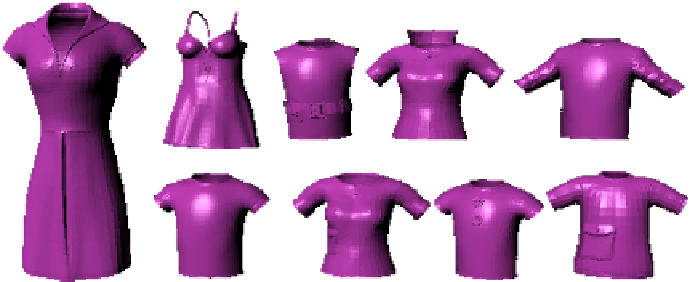Graphics Reference
In-Depth Information
Table 1.
Some Results of the conditional probability table of component node
Garment Style
Collar Style
No|Stand|Fold|Flat
Pocket Style
No|Patch|Side|Insert
Belt
Exist|Not Exist
T-shirt
0.7 0.0 0.3 0.0
0.7 0.3 0.0 0.0
1.0 0.0
Shirt
0.0 0.0 1.0 0.0
0.0 1.0 0.0 0.0
1.0 0.0
Skirt
0.9 0.0 0.1 0.0
0.9 0.1 0.0 0.0
0.6 0.4
Coat
0.2 0.1 0.7 0.0
0.1 0.4 0.1 0.4
0.9 0.1
Suit
0.0 0.0 0.0 1.0
0.0 0.6 0.4 0.0
1.0 0.0
Fig. 5.
Some generated garment results using our method
7
Conclusion
We present a probabilistic virtual garment modeling method which facilitated the 3D
detailed garment modeling. Our system can automatically present the garment
components to user during the modeling process. The system can infer the implicit
garment style and suggest related garment component part. We also propose a cage-
free method based on a mean value coordinate for part stitching. This method is
rotation and scale in-relevant. It reduces the part alignment process and can preserve
the smoothness of the part surface. It is fast and effectively.
Currently, we have learned the Bayesian network which encoding the relationship
among garment components from pictures, and we just take into account the garment
component style attributes, but it is flexible to add additional attributes such as
texture, material and shape, etc.
In the future, we plan to take into account the spatial relationship of garment
components which may reduce the labor of specifying corresponding vertices and
make the garment modeling process faster.
Acknowledgments.
We would like to thank the anonymous reviewers for their
valuable comments. We were supported by the National Natural Science Foundation
of China (61379112, 61272192).



Search WWH ::

Custom Search